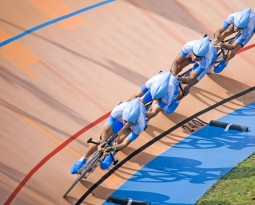
British Cycling has become one of the most celebrated UK sporting success stories from the last fifteen years and now Britain is considered to be one of the top cycling nations.
The enormous successes in the Olympics in Beijing and London and the Tour de France were due to what Performance Director Dave Brailsford described as ‘the aggregation of marginal gains’. This article asks what lessons we can learn from Brailsford’s approach in transforming our own proposal management capability.
Brailsford did not look for one or two big changes but rather dozens of smaller changes that, when combined, would produce the required step change in performance.
They looked at the obvious and not so obvious.
They looked at the design of the bikes to reduce weight and drag factors.
They looked at training schedules and nutrition of the athletes.
And they looked further; they looked at which seats to sit on in the plane, which pillow provided the best night’s sleep, and how to avoid infections during competition time with effective hand-washing. Brailsford and his team searched for 1 percent improvements everywhere.
And the results speak for themselves as British Cycling has become the best in the world.
But the aggregation of marginal gains was only part of the story. An equally powerful strategy was deployed in parallel; the strategy of focusing on and improving lead measures.
Lead measures are an important component in improving performance. They provide useful predictors of future performance. Unlike most backward looking goals – win the race, improve win rates, increase capture ratios – lead measures provide indicators to outcomes that can be influenced by the performance of the team. The rationale is simple; get the lead measures right and the outcome takes care of itself.
So, rather than focusing on winning medals or a certain number of races (outcomes), Brailsford used lead measures to track progress; the speed of the first 100m, the first lap time and, in the team events, who went to the front first and who led in the final lap.
These factors, all within the control and influence of the cyclists, were highly predictive of final results and provided the focus for feedback and improvements. Cyclists could be selected to perform specific jobs – quick start, pace setter, step-up-the-pace, fast finish – so that if lead measures weren’t being achieved, the right person would take over the lead and get the team back on track.
What are the lessons for proposal professionals?
Rather than focusing on win rates and capture ratios (which are lag measures / outcome goals) focus instead on the factors that are considered most predictive of improved performance.
Losing too much? Tighten up the qualification process, pay more attention to kick-off meetings and reviews, and increase the skill level within the team; all these factors are highly predictive of the final outcome and can be influenced by the bid leadership team and so are worthy of consideration as lag measures.
The hard bit is making the change stick. Identifying the one or two changes that will make the biggest difference and then holding each other accountable until the changes are embedded and become ‘the way things are done around here’.
Focusing on one lead measure at a time, holding the team accountable until the change is embedded and then, and only then, identifying the next lead measure that you consider will make the biggest difference.
It worked for British Cycling; it will work for you. Get pedaling!
Ian Sherwood is Director of Transformation at twentysix2
Performance benchmarking is a way of establishing lead measures by identifying the one or two changes that will make the biggest difference to performance. For bid and proposal managers, the Proposal Management Capability Assessment Tool will help you to find the shortest route to the biggest improvement; we call it taking the racing line.
Image ref: Copyright: www.123rf.com/profile_shariffc





